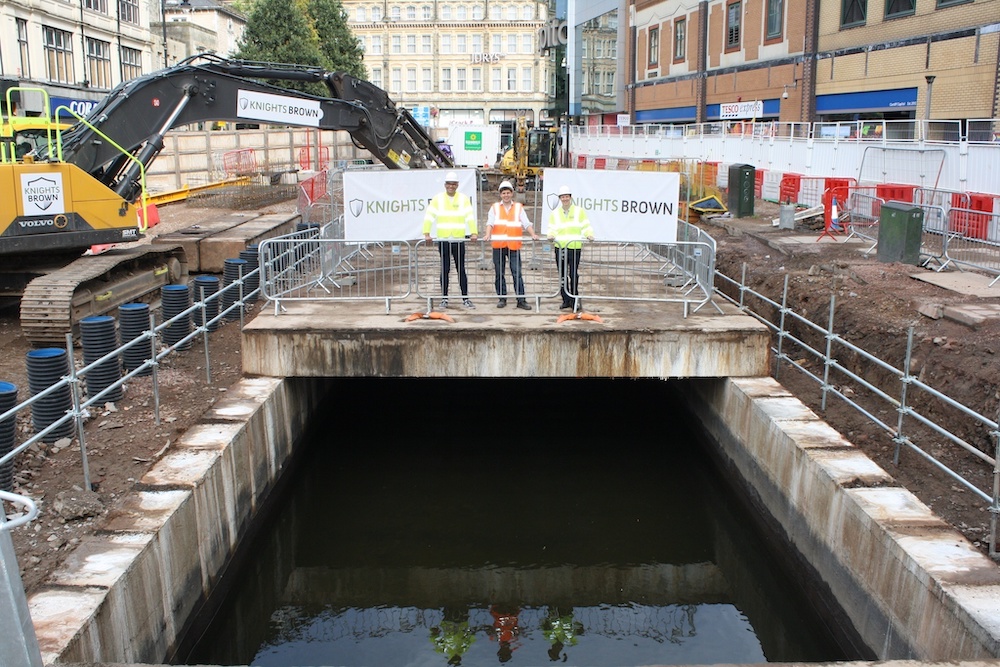Canal that has lay hidden in Cardiff city centre is uncovered

The dock-feeder canal underneath Churchill Way in the centre of Cardiff has resurfaced after almost 80 years – with the ongoing removal of sixty-nine 7.5 tonne concrete beams that separates the canal from the carriageway.
Seventy metres of the dock-feeder will be fully uncovered by the end of next week, with work underway to build two footbridges across the canal, as part of the scheme.
The dock feeder on Churchill Way serviced the 25-mile-long Glamorganshire Canal from Merthyr Tydfil to Cardiff – which brought steel and iron down to the city. The dock-feeder provided water to the docks in Cardiff Bay, to ensure the docks could operate 24 hours a day, even at low tide.
The dock-feeder was covered up between 1948 and 1950 when the Glamorganshire Canal finally closed and is now being uncovered as part of a wider masterplan to create a new vibrant Canal Quarter in the east of the city.
The re-emergence of the canal will create a new water habitat in the city centre with blue/green, public space, and rain gardens to manage surface water drainage. New outdoor seating in an amphitheatre style will also be delivered, along with an outdoor performance area.
Here’s some visuals on what it might look like. https://t.co/rHAZw95kN6
— I Loves The 'Diff (@ILovesTheDiff) September 7, 2022
Work is also underway to deliver a new segregated cycleway on Station Terrace with wider pavements and better crossing facilities, and a new improved junction between Adam Street and Churchill Way.
Cllr Dan De’Ath, Cabinet Member for Strategic Planning and Transport, said: “The opening of the dock feeder canal and the new transport scheme will not only mark the beginning of a new district centre for the city and act as a catalyst for new investment, but it will play an essential role in managing traffic flow and surface water drainage in the city centre.
“A series of rain gardens will be built, with specific soil and planting to treat the surface water to remove pollutants before the water flows into the canal. This will ensure that 3,700 m2of water will be diverted away from the sewage system each year, reducing the cost and energy of treating this water through the sewage pumping station at Cardiff Bay.”
This project is part of a wider masterplan to develop a new district in the city, interlinking Bridge Street, David Street. Charles Street, Tredegar Street, Guildford Crescent, and Barrack Lane to develop a high-density, mixed-use development, attracting homes, hotels, hospitality, high quality offices, leisure and retail units.
Support our Nation today
For the price of a cup of coffee a month you can help us create an independent, not-for-profit, national news service for the people of Wales, by the people of Wales.





If nothing else, thecouncil can revert to the old names of the streets on either side of the feeder and drop the reference to the murderer.
It looks….good. I’m not used to Cardiff Council thinking into the future as it’s so often moves to increase congestion into town and replace culture with high-rises for imagined students.
Oh, for goodness’ sake stop perpetrating balderdash. The Dock Feeder ( no need for ‘canal’) starts from Blackweir, runs through Bute Park to turn left through the North Moat and across under Kingsway alongside Boulevard de Nantes until the other side of Park Place near the New Theatre where it has a right turn under the new student accommodation tower block and down behind Jury’s ( the old Park Hotel) to cross Queen Street by the old Pembroke Terrace ( under Churchill Way) It NEVER had anything to do with the Glamorganshire Canal! Its waters are completely separate!! Why are… Read more »